Carob is one of the most wholesome sweets among healthy nutritionists. In terms of taste, it is very reminiscent of cocoa, but in properties far exceeds it. What is carob? These are powdered carob fruits grown in the Mediterranean countries - Spain, Italy, Cyprus. For growing trees are not whimsical, they grow in the wild. The fruits are picked slightly immature and then dried in the sun. Despite its usefulness, carob can be even dangerous if used improperly. That is why you should know the composition of the product, its properties, and cases of contraindications in order to understand all the benefits and harms of carob. This will help to use the powder with health benefits.
It is interesting that the carob grains have exactly the same mass and size. This feature was used in antiquity as a measure of mass (carats). To this day, this measure is used in the pharmaceutical and jewelry business to determine the mass of substances (precious metals and other things).
Material Content:
Carob. What it is?
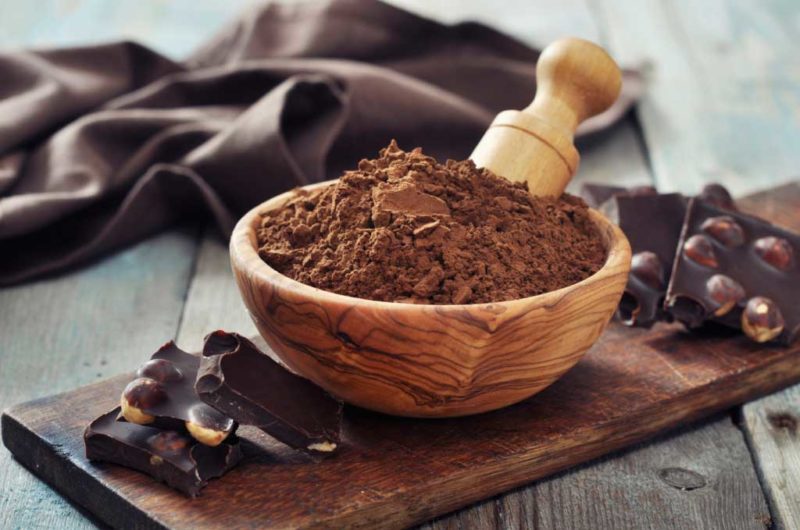
What is carob for nutrition?
Carob is a natural food powder obtained by grinding carob. In appearance, taste and smell, it resembles cocoa, but the properties are much more useful.
- Firstly, carob is not treated with chemicals, as it is practically not susceptible to disease.
- Secondly, the fruits themselves are sweet, and refined sugar is not required to make the sweet powder. True, in order to get sweet fruits, you need to remove the unripe pods from the tree and place them in the sun. Then they will ripen and become sweet.
- Thirdly, carob fruits do not contain caffeine, which is also used by people to whom it is contraindicated. Carob is allowed even for pregnant women.
The carob tree itself or Ceratonia (from the Greek "ceratos" - horn) is an evergreen tree that does not require special care. Fruits - large pods 20-25 cm long, resembling horns (hence the name).
Carob Composition
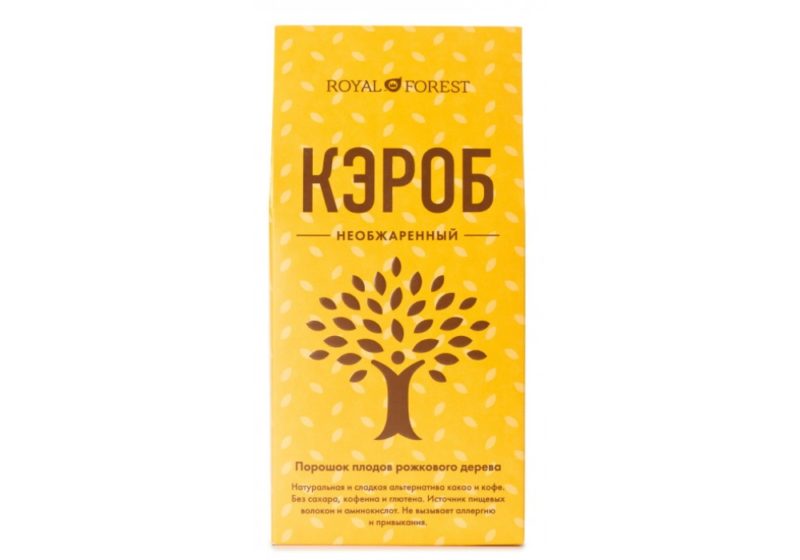
- Protein or protein. Carob contains a fairly large amount of protein (up to 8%). This substance is a structural component of amino acids, nucleic acids and all body cells. In addition, the protein content provides its energy value.
- Vitamins Carob contains a large amount of B vitamins (in particular, B1, B2). They are necessary for the normal functioning of the nervous system, support metabolic processes. Interestingly, it contains more vitamins of this group than in legumes or strawberries. Carob is also rich in vitamin A (retinol), which is necessary for healthy eyes, skin, and hair. Vitamin D (calciferol) regulates the exchange of calcium and phosphorus in the human body, thereby normalizing the functioning of the musculoskeletal system.
- Saturated fatty acids (EFAs) are found in small amounts in carob. It is believed that these fats are harmful to the body. This is not entirely true. In a large number of EFAs are deposited on the walls of blood vessels, clogging their lumen. But in a small amount (daily rate of 25% of all fats), these fatty acids are a source of energy for cells. Due to their presence, the successful absorption of fat-soluble vitamins (A, D, E, K) occurs.
- Trace elements. Carob contains a large amount of phosphorus and calcium (as well as vitamin D for assimilation). Therefore, its fruits are useful for the prevention of osteoporosis. In addition, carob is rich in potassium and magnesium, which are necessary for the functioning of the cardiovascular and nervous systems. Iron is contained in the form in which it is easily absorbed by the human body. A small amount of copper, zinc, manganese, nickel, which are part of the composition is quite enough, because the need for these elements is small.
Beneficial features
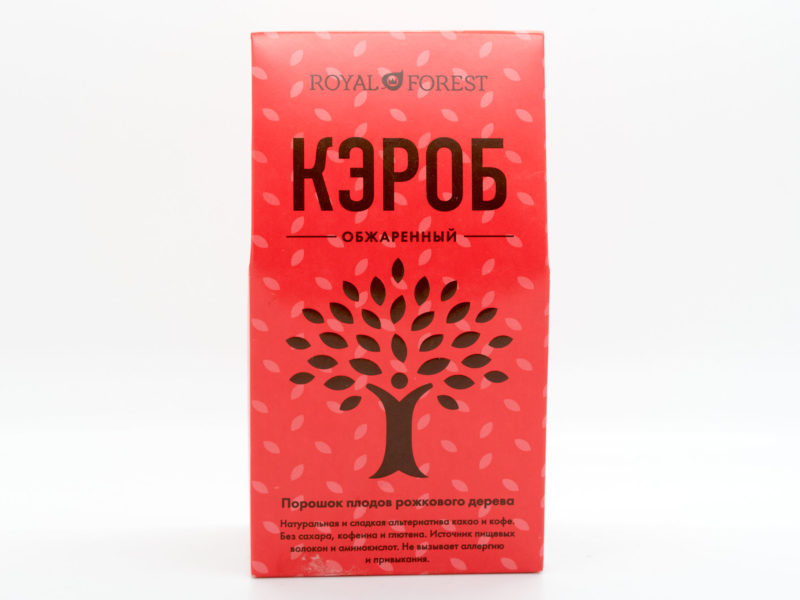
Due to its rich composition, carob is widely used in dietetics (as a component of diet food) and, in some cases, in medicine. Due to its taste, it is widely used in cooking. Carob is called "healthy chocolate." And all due to the fact that this powder does not contain substances that are rich in cocoa.
- Does not contain salsolinol - a substance that is addictive and is found in cocoa beans. It is because of it that some people are addicted to chocolate.
- Does not contain phenylethylamine - a chemical compound that has a psychoactive effect and changes the state of human consciousness. In small quantities, this compound is found in cocoa and can cause headaches in sensitive people. Carob, unlike chocolate, precisely because of the lack of phenylethylamine, has a calming effect on the nervous system.
- Does not contain theobromine - a substance with a pacemaker effect (increases strength and heart rate) and a diuretic effect. In large quantities, it can lead to tachycardia (increased heart rate) and increased blood pressure.
- It does not contain caffeine - a substance that has a stimulating effect on the nervous system, heart, blood vessels. In large quantities, it leads to a narrowing of blood vessels, which is fraught with an increase in blood pressure, headache.
- It does not contain oxalates (in particular, oxalic acid). Its presence in the body in large quantities impedes the absorption of calcium and zinc, necessary for the normal functioning of cells and muscles.
- Reduces blood cholesterol. This action becomes noticeable with the systematic daily use of carob.
- It contains a large amount of fiber, which helps to cleanse the intestines with constipation, enhancing its peristalsis.
- It has antioxidant properties.Carob contains a large amount of antioxidants that bind free radicals, preventing oxidation of the body and premature aging.
Such diverse beneficial properties of carob are widely used for:
- diabetes treatment (as a dietary supplement, but in minimal doses),
- obesity (carob has the ability to suppress appetite, creating a feeling of fullness),
- vegetative-vascular dystonia and migraine (chocolate and cocoa are contraindicated in such patients),
- food allergies (carob does not act as an allergen, unlike chocolate).
Benefit and harm
Like any other product, carob, if used improperly or excessively, can harm the body. Therefore, if there are any diseases, it is better to consult a specialist before taking.
The greatest danger is a large amount of carob and products from it are for diabetics. Immediately after consuming the powder in the blood, the sugar level rises slightly, which is directly proportional to the amount of food eaten. Therefore, when drawing up a diet, you need to be extremely careful and take into account the amount of glucose in the blood.
The product can cause harm if you are hypersensitive. Therefore, people who use carob for the first time, you must first try it and follow the reaction of the body. It is unlikely, but possible, and if manifested, it is better to exclude the product from the diet.
The use of carob in cooking
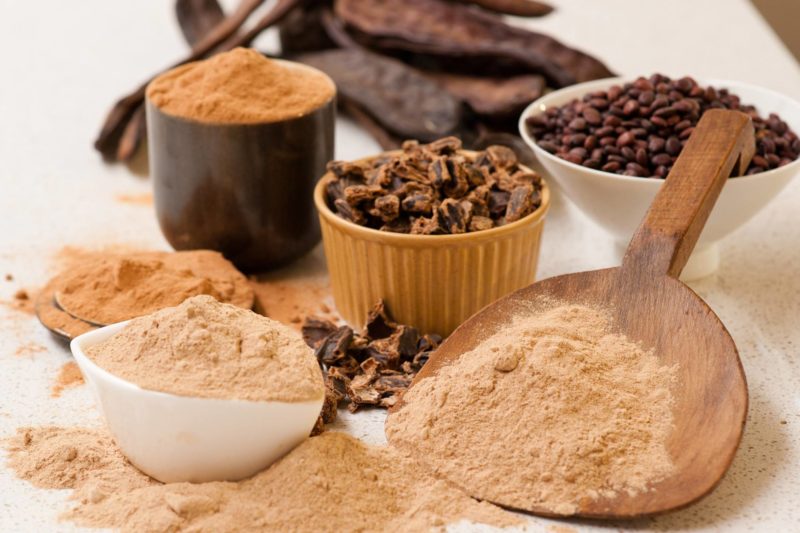
The same powder, reminiscent of the taste and smell of cocoa, is prepared from the peel of the carob pods. On sale you can find powder from ground raw pods. In appearance it is pale pink, very sweet, but the taste is far from cocoa. From slightly fried pods, a yellow-brown powder is obtained with a sweetish caramel taste and a characteristic dark brown color and smell. It is not sweet, on the contrary, it is slightly bitter.
In cooking, the same products are prepared from powder as from chocolate. Products differ in that they do not contain sugar. Candy, tiles, carob lollipops can be consumed by people with diabetes and children. A variety of drinks are prepared: hot carob chocolate, tea, liquors, compotes, as well as puddings, cookies, cakes, ice cream and much more.
Carob syrup has special properties. It is used for weight loss, treatment of diseases of the bronchopulmonary system, gastrointestinal tract, to normalize sleep during chronic stress and insomnia, with severe intoxication of the body. To prepare such a tool, the carob pods should be boiled in water. It turns out a very sweet syrup, a tablespoon of which must be mixed with a glass of boiled water, add lemon juice to taste and drink 15-20 minutes before eating. After eating it, a person feels some satiety and eats less than the usual amount during meals.
Calorie Carob
This product is considered low calorie. 100 grams of carob contains only 222 kcal, which is half as much as cocoa.
Carob Recipes
Chocolate cake
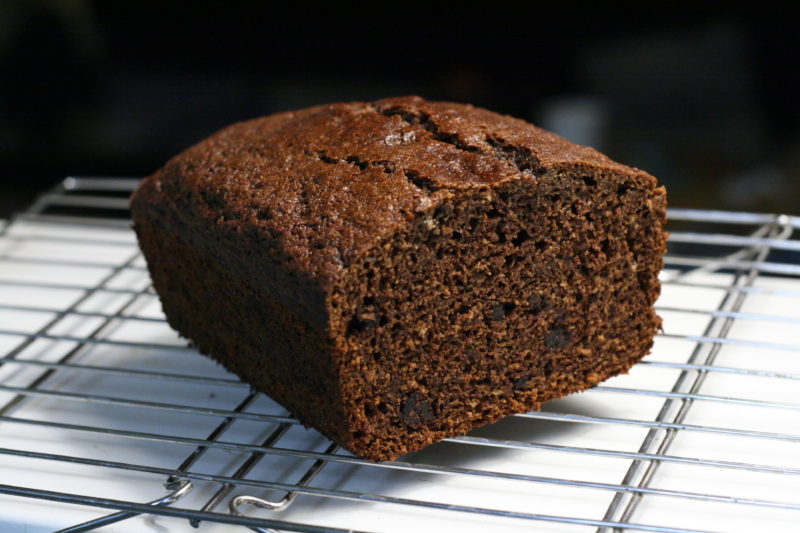
For cooking, you need 200 grams of butter, after melting, add 4 tablespoons of carob powder, 1.5 cups of sugar and half a glass of milk. Mix all ingredients, bring to a boil, then cool. At this time, extinguish 0.5 teaspoon of soda in a glass of kefir and add the mixture to the icing. Stir and combine with two glasses of flour. Knead the dough. You can add raisins, nuts, vanilla or cinnamon to taste. Put the dough in a cupcake mold and bake at a temperature of 200-220 degrees 40-50 minutes. The cupcake is ready.
Instant candy
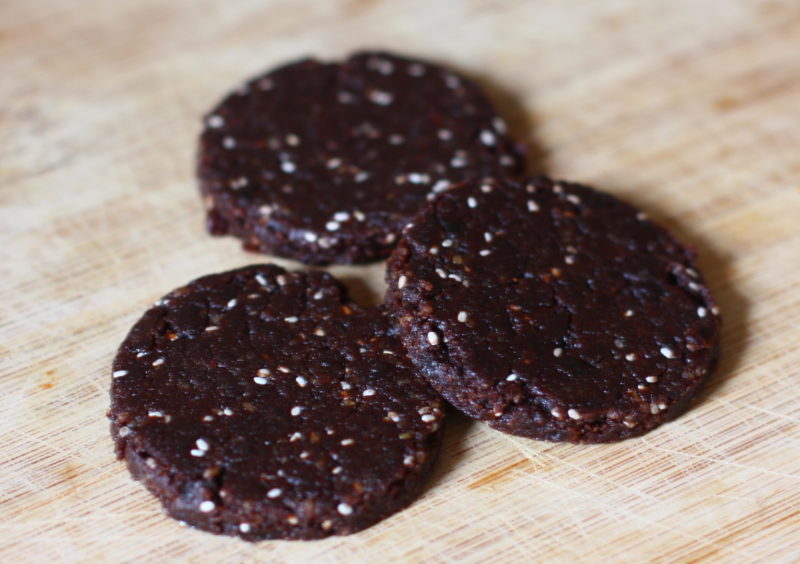
Such sweets are the safest and are allowed even to children, as well as patients with food allergies and diabetes. To prepare the sweetness, you need to melt in a water bath 100 grams of cocoa butter and 50 grams of carob powder. It should be a liquid mass. Then pour 50 grams of milk powder. The resulting mixture should have a consistency of thick sour cream.To taste in sweets, you can add nuts, dried fruits. To form sweets from the finished mixture, after which they can be dipped in sesame seeds or coconut. Put in the refrigerator and in an hour the candies are ready!
Powder Based Flavor

How to make a drink from carob? Simply. It is prepared by dissolving a teaspoon of the powder in boiling water or milk. Sugar can not be added, carob itself is sweet.
Carob Tea
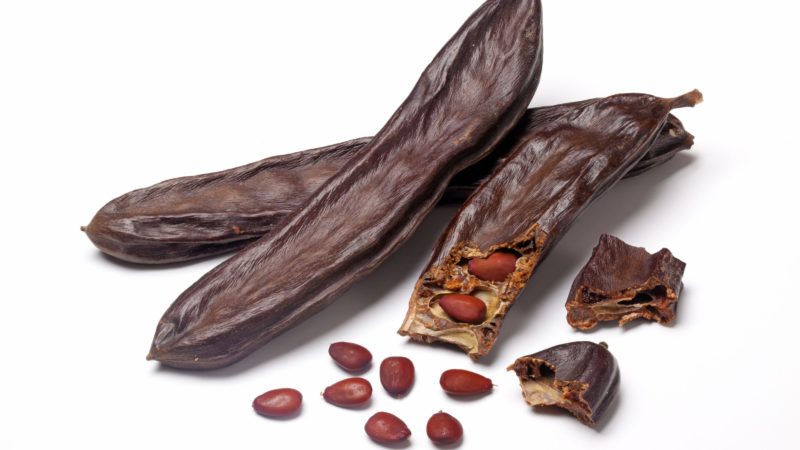
For cooking, you need not powder, but pods. They need to be crushed, boiled in boiling water and insisted for 15-20 minutes. Tea is ready. It resembles dried fruit compote to taste.
Carob is a great alternative to chocolate.
It is very appreciated by the sweet tooth and people who are contraindicated in chocolate and cocoa. Indeed, in taste it is not inferior to these products, and in terms of properties it is much more useful. Thanks to its healing properties, carob has earned an honorable place in medicine. Therefore, if there is a choice between cocoa powder and carob, give preference to the latter.












